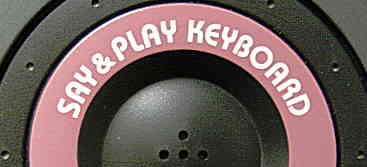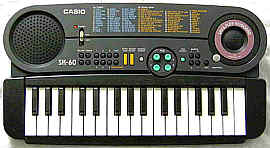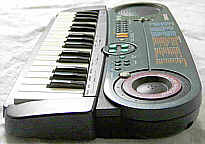 |
CASIO SK-60
lo-fi sampling keyboard with vocal percussion & sound effects |
 |
CASIO SK-60
lo-fi sampling keyboard with vocal percussion & sound effects |
This instrument from 1996 (PCB stamp "MAY 22 1996") was AFAIK the last small sampling keyboard made by Casio. Although it was more designed like a toy than the other SK series keyboards (there is e.g. no sound output jack), it is one of the more interesting ones, because it features various special sound effects.
 |
 |
 |
The preset sounds are made from medium resolution loop samples and most sound fairly realistic. The sound engine differs significantly from the classic Casio SA series wavetable hardware because it has not only higher polyphony but also has a much higher tempo resolution and employs neither chorus nor reverb nor echo effects in its sounds. The volume control here also affects held notes, but selecting a new preset or sample sound does not change them. Fortunately also button presses play no unnecessary noises anymore and there is also no battery alarm or similar.
The "piano" sounds quite realistic. The "elec piano" resembles a Rhodes piano. The "organ" is a plain Hammond organ tone with percussive click. The "guitar" is an acoustic one. The "vibraphone" has only very weak vibrato. The "violin" sounds quite harsh with weak delayed vibrato, while "strings" seems to be rather a loop sample of a string orchestra than a synthetic chorus sound. "trumpet", "clarinet", "flute", "sax" have a slow vibrato. The "siren 1" is a fast howling and slowly louder fading siren. "siren 2" is a slowly louder fading ambulance siren which pitch goes down and fades silent after key release (like being overtaken by an ambulance). The sounds "telephone", "space 1", "space 2", "funny" are nice tekkno effect split sounds those are different from the SA series; unlike with SA series keyboards, here all keys play different pitches. "telephone" = {phone toot, digital phone ring, pulsed digital phone ring(?), engaged tone, short sine beep}. "space 1" = {slowly down and up wobbling pulsed siren, faster up howling siren, up and down howling glissando siren}. "space 2" = {digital phone ring layered with pulsing bass, pulsing bass toot followed by up howling siren that fades silent}. "funny" {wobbling siren varying pitch amplitude, sequencer loop pattern of 3 tones}. The "human voice" sounds are short loop samples with delayed vibrato and remind much to historical Fairlight CMI sample choirs. "aah" and "ooh" sound like a children choir. "bah (bass)" is a male voice with strange fluttering loop point. "voice percussion" is a drum kit mode with voice and snap sounds: {"guer!" (male), imitated snare (or analogue transistor noise snare?), "sh!", finger snap}; all sounds can be played on a few different pitches. The "human voice (cycle)" sounds are sequences of 2, 3 or 4 of the normal "human voice" sounds; every new key press starts a new sample of the sequence. The same thing can be also done with the 4 user samples. (This concept may be a crude predecessor of the professional Roland VariPhrase hi-end sampler keyboards.)
Instead of normal rhythms there are only so-called "free sessions", those are basically like demo songs without main voice those can be improvised to. This concept resembles much the "jam tracks" on Yamaha PSS-6 or PSS-31, except that the main voice preset is not automatically changed during the track, but only during selection of a "free session". (Each has one corresponding default preset sound.) Interesting is that many of the accompaniments include voice samples, and with the "magical singer" button also the rest of the percussion sounds is replaced by voice percussion and also the main voice by a human voice sample. (All samples are taken from the main voice presets.) Pressing the button again switches rhythm back to normal drum kit percussion and the main voice to the default preset sound of the current "free session". By the many vocal accompaniments the musics remind much to gospel or blues choirs.
Also the first 11 of the 24 demo songs employ vocal sounds, while the rest can be switched to vocal mode with the "magical singer" button. The 24 demos are:
By the lack of an input jack, the sampler can be only fed through the internal microphone. Samples can be tuned, reversed or looped. Each sample can be tuned, reversed and repeated in a loop. Instead of 4 short samples also 2 longer or 1 long sample can be stored by selecting "time" {S, M, L} (which erases the sample memory). Up to 4 samples can also play in a sequence (each key press plays the next one) by selecting the "cycle" functions. All sampling edit functions are selected through white keys + "edit" button. The 4 samples are automatically assigned to the 4 rubber pad buttons {A, B, C, D}. Interesting is that the pads always add a simple envelope, thus the sample is only played to the end by holding down the pad, while a short press only plays the begin of that sample. With the "pad effect" button the sounds from the pads are sent each through a fixed default effect: "A"= chorus, "B"= strong square vibrato, "C"= pitchbend up, "D"= pitchbend down. The chorus resembles rather a cold and disharmonic dubbing. The square vibrato rings disharmonic with about 5Hz like a digital telephone ring. The pitchbends bend up or down by about an octave during a second; they make a lot of zipper noise and thus resemble more a portamento than a glissando. Unfortunately apparently neither the order of the effects nor of the samples in the memory can be changed, thus to apply a different effect to a sample is not possible without recording it again on a different sample number (erasing the previous one on that number).
After power- on, the 4 pads are always assigned to the 4 "voice percussion" sounds {"sh!", snap, "guer!", pseudo- snare}. As soon any sample is selected or the "pad effect" button is pressed, the pads are switched to the 4 samples and can not be switched back to "voice percussion" without switching the instrument off. With no samples in memory, the pads are instead assigned to {"doo (female)", "be (female)", "dee (female)", "bah (female)"}.
Important: I have no manual for this instrument, thus there may
be some features I don't know.
hardware detailsThe Casio SK-60 is built around the CPU "OKI M6755B-10" with external 32KB RAM.
This analysis is based on the Casio SK-60 service manual. keyboard matrixThis keyboard matrix is based on the Casio SK-60 service manual. I haven't analyzed it by myself, so there may be still unknown eastereggs. Each KI# pin at the CPU has a 2.2k resistor and each KO# pin a 1k resistor in series.The KO pin numbering is shifted by 1 versus the CPU pin name in schematics (i.e. CPU pin KO1 is KO0, KO2 is KO1 etc.) which is likely a service manual bug, because in other keyboard schematics they start correctly with KO0. The matrix layout (e.g. button positions) strongly differs from other
keyboards with M6755x CPU, which hints that it is not derived from the
same software and won't include their eastereggs.
The input lines are active-low, i.e. react on GND. Any functions can
be triggered by a non- locking switch in series to a diode from one "in"
to one "out" pin.
|
Predecessors of this instrument include the Casio
SK-1 (first Casio sampler, great synth features, blip percussion),
SK-5
and
SK-8 (with ROM-Pack, key
lighting, upgradeable as oriental keyboard) those all have interesting
features, but none is really similar like the SK-60. Much info about Casio
SK instruments can be found on the internet.
| removal of these screws voids warranty... | ||
 |
||
|
|